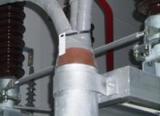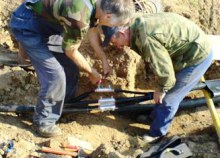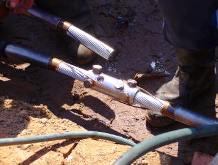Connection and termination of power cables
 For connecting and terminating power cables, as well as for their connection to electrical equipment, cable glands and special cutting.
For connecting and terminating power cables, as well as for their connection to electrical equipment, cable glands and special cutting.
To meet the quality requirements of connectors, electricians who have a high qualification (not lower than the fourth grade) and passed special courses. Installers must have certificates for the right to produce the installation of connectors of the corresponding category. The certificate is renewed with the passing of instructions every three years.
Ways to connect cables
Union power cables made in such a way that the resistance of the transition does not exceed the resistance of the entire section of the core, and the dielectric strength of the insulation in the junction is the same as that of the others.
The connection point is reliably protected from moisture penetration and mechanical damage. The paper-insulated cables are connected in sleeves, and the joints of the umbilical cables are hot vulcanized and varnished.

The couplers for 20 and 35 kV cables are single-phase in brass housings.
For vertical and steeply inclined laying with a difference in levels of more than 15 m, a cable with impregnated paper insulation is installed at the junction with a stop sleeve. These connector sections prevent the impregnating compound from flowing through the cable.
Cables up to 10 kV including can be connected in connectors made of epoxy compound. The body of such a connector and spacers are manufactured in factories.
For connecting and branching cables with a voltage of up to 1 kV, connectors without factory-made housings can be used. In this case, the compound is poured into removable metal or plastic molds.
Epoxy bushings similar in design to oil paper insulated bushings are suitable for plastic insulated cables.
Cable clamps must seal the insulation, protect the cable end from mechanical damage and remove the insulated conductors.
In dry rooms, the cable is finished with funnels and dry ends of polyvinyl chloride strips and "gloves" of lead and rubber. Cable-end bushings are used outdoors and in all but dry rooms. The core insulation above the funnel or sleeve is reinforced with tape, tube or varnish covers.
Steel funnels in dry rooms terminate cables with paper-oil insulation up to 10 kV. For voltages above 1 kV, the funnels are made with porcelain bushings.
In indoor and outdoor installations, with full protection from precipitation, dust and sunlight, epoxy resin seals can be installed. They are recommended for use in electrical installations up to 10 kV.
In indoor installations up to 10 kV it is possible to carry out interruptions with lead gloves and up to 6 kV in addition with rubber gloves.
Lead gloves are stronger and more reliable in operation, but more expensive and more difficult to manufacture and install. They are convenient as bottom terminations at different levels of cable ends. Rubber gloves are not allowed with a difference in levels of 10 m or more.
In the upper part of the cable, at different levels at its ends in horizontal sections, dry ends of polyvinyl chloride ("vinyl") tape are often used. They can be installed in rooms with temperatures up to 400 ОВ. These seals have high chemical resistance, are relatively easy to work and manufacture, and are also the cheapest.
Metal cable glands for voltages up to 10 kV for outdoor installation have vertical or inclined conductors. Terminals for 20 and 35 kV cables are single-phase. The clutch body is cast from cast iron or aluminum alloy. Attached to it are porcelain bushings, the rods of which are connected to the cable ends inside the sleeve.
Use of heat-shrink sleeves to connect cables

In recent years in the world installation practice, widespread heat shrinkable materials obtained from conventional thermoplastics through their radiation, radiation-chemical, chemical and other processing.
In the processing process, the linear structure of the molecules is cross-linked with the formation of elastic cross-links between them. As a result, the polymer acquires improved mechanical characteristics, increased temperature and atmospheric and corrosion resistance, durability.
The main merit of heat-shrinkable connectors — «shape memory», that is, the ability of products made of heat-shrinkable materials, pre-stretched in a heated state and cooled to ambient temperature, retain their stretched shape for an almost unlimited time and return to their original shape when reheat to 120-150 °C.
This property allows not to limit the tolerances during assembly, which greatly simplifies the assembly and assembly works and reduces their labor intensity.
Sealing and sealing products have an inner sub-layer that melts when the stretched product is heated (shrinkage) and is pressed into all the irregularities of the product being sealed by the force of shrinkage. Upon cooling, the sealing sublayer hardens, resulting in reliable adhesion and sealing of the products.
When installing, connecting and terminating power cables, they also use various heat-shrinkable tubes, cuffs, which facilitates and simplifies the installation of connectors. A wide range of heat-shrinkable individual parts allows the use of one standard joint size for several cable types and cross-sections, which in turn significantly reduces the need for spare joints in storage.
